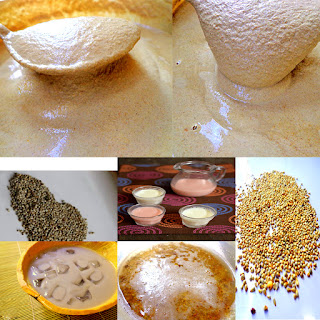CORN RECIPES (OGI/AKAMU/PAP AND
CUSTARD)
Traditionally processed Ogi/Akamu/Pap,
with the distinctive sour taste, is a great partner to Fried Plantain, Pancake,
Akara, Fried Yam, Puff Puff etc. Any of these when combined with Akamu, makes a
great breakfast meal. Akamu is also a great baby food.
Akamu is simple, yet very difficult
to prepare. It is a big challenge for a lot of people.
Most people usually add evaporated
milk to their custard or Akamu meals so the main requirement is that the
akamu/ogi/pap or custard is thick after preparation so that when the milk is
added, a perfect consistency will be achieved.
What
you will need to make Akamu/Ogi/Pap or custard
Wet
Corn Starch (Akamu, Ogi, Pap or Custard)
- Water (Hot and Cold)
- Evaporated Milk
- Sugar (to taste)
Notes about the ingredients
1.
If you can't buy or make Akamu from
scratch, you can use corn starch (corn flour) but the classic sour taste will
be missing.
2.
Evaporated milk is the best milk for
ogi. Whole milk, semi-skimmed or skimmed milk are not great for akamu. If
making Akamu for your baby, use baby milk.
3.
Add sugar to your taste. Do not add
sugar for babies.
Preparation
1.
Put some lumps of akamu/ogi/pap or custard
into a sizable bowl. Akamu rises during preparation so you should use a bowl
big enough to contain the meal in its risen state. If in doubt, use a very big
bowl, with time, you will learn which quantity can comfortably fit which bowl
size.
2.
Use a tablespoon to crush the lumps
of ogi into very small pieces.
3.
Add cold water in small quantities
and mix till you have a medium consistency with no lumps.
4.
Put a kettle of water to boil. Make
sure the water will be enough. It is better to boil too much water than not
have enough water when making akamu or custard.
5.
Just before the water boils, stir
the mix very well because some of the custard /ogi may have settled at the
bottom of the bowl. If not stirred well, this is the major cause of lumps when
you start making it.
6.
Once the water boils, pour it slowly
but steadily in a circular motion into the bowl of custard /akamu and stir at
the same time. Pouring the hot water slowly and stirring at the same time is
very important because this prevents lumps.
7.
Once you see the mixture setting,
stop stirring and reduce the flow of water you are pouring till the custard/
akamu has completely set.
8.
Set the kettle aside and stir the
pap very well. If it is too thick for you, you can add more hot water. But be
careful else it will become watery. Remember that you will still add liquid
evaporated milk.
9.
Add evaporated milk and some sugar
to taste and stir everything to the way you like it.
Akamu/ Custard goes well with Akara,
Fried Plantain, Moi Moi, Pancake, Fried Yam, Beans Porridge, Fried Potatoes,
Okpa and Puff Puff.
 Kunu drink is a
popular drink made from whole grains of millet and sometimes sorghum or corn.
Its quite popular in most parts of Nigeria especially the northern
part where it originates. It’s got a spicy, nutty flavor and it’s packed with
nourishing vitamins and minerals. It’s also rich in protein and high in fiber.
Preparation of this drink takes about a minimum of 2-3 days. This is because
for the first two days, it’s left to soak in water so as to trigger the process
of fermentation. Making Kunu at home is quite easy and requires nothing
fancy.
Kunu drink is a
popular drink made from whole grains of millet and sometimes sorghum or corn.
Its quite popular in most parts of Nigeria especially the northern
part where it originates. It’s got a spicy, nutty flavor and it’s packed with
nourishing vitamins and minerals. It’s also rich in protein and high in fiber.
Preparation of this drink takes about a minimum of 2-3 days. This is because
for the first two days, it’s left to soak in water so as to trigger the process
of fermentation. Making Kunu at home is quite easy and requires nothing
fancy.